Exterior Design Strategies for Placemaking Downtown
Efficient, Color-Correct Lighting with BUG Ratings
High-quality, architecturally relevant landscape lighting offers a broad array of tools for the architect's lighting palette. LEDs are being installed from large commercial applications, hotels, schools and government buildings to residential homes. LEDs are becoming popular because they not only save energy dollars, they also create a friendly atmosphere. The latest LED technology is a sophisticated system of lighting diodes that provides opportunities to maximize both color and light levels in outdoor environments. They are being used in homes, courtyards, public parks, commercial rooftop gardens as accent lighting or to light a building facade or sculptural detail. An LED light comes in many forms and one of the main advantages is that these lights are energy sippers. A low-voltage LED can save 70 percent more energy when compared to other sources of lighting on the market.

Photo courtesy of Bison Innovative Products
Downtown New York City rooftop putting green gives employees a new way to take their “coffee break.”
When selecting an LED lighting product it is important to understand the location where it will be installed. The advantage of this energy-efficient lighting is that it can also be adjusted for color correction and intensity. It can also be rated for compliance to Dark Sky ordinances.
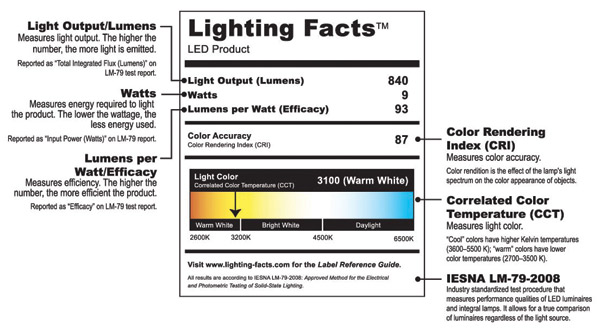
Image courtesy of Kim Lighting
Lighting label for LED lights.
Cool, hip, and attractive nighttime lighting is appearing in many downtowns, on urban rooftops, and in parks and event spaces. Product labels for LED lighting include information on lighting efficacy in lumens/watt, color temperature, and its Color Rendering Index (CRI). The CRI is particularly important when specifying a light system for a specific feature. With the wrong choice for color temperature, a cozy warm park bench becomes a forbidding alcove, trees appear to have orange leaves, and the red brick wall appears to be brown and colorless. Sensitivity to color in the environment is a skill and some manufacturers will provide color consultation when the designer is trying to specify the correct Correlated Color Temperature (CCT) and/or CRI. LED diodes do not have special lenses as the diodes are calibrated to provide accurate colors to illuminate the project as designed.
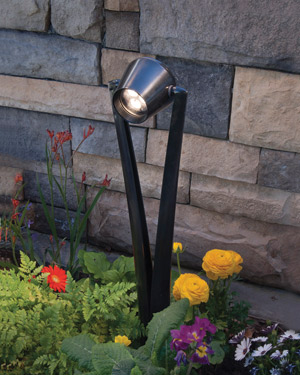
Photo courtesy of Kim Lighting
Different white light can be selected as a light source to effectively highlight flowers and shrubs.
In a recent blog post, Chris Bailey, director of Lighting Solutions Center at Hubbel Lighting, explains the difference between CRI and CCT and provides definitions and explanations as to why the color composition at the source of lighting is important. Because accurate color renditions can greatly affect the appearance of an object, it is key to understand the importance of selecting a complete lighting system rather than just replacement lamps. The advantage of specifying a whole LED lighting system rather than specifying replacement lamps is that the color temperature and lighting efficacy will be maintained over the life of the project.
“Similar to CRI, CCT is only part of the color story. It is simply a designation given to a light source to describe the color appearance of the light emitted by a lamp, but does not provide information regarding the range and level of colors of the source. It is for this reason, possibility among others, that two lamp sources can have the same appearance, but produce very different effects on the illuminated environment. This phenomenon can often be observed when a facility is re-lamped. While a facilities worker may take note of the marked color temperature as he or she begins to replace the original lamps in the luminaire, the replacement lamps are often selected based on their pricing and availability. As a result, the differences between the original and new lamps can often be seen in the colors reflected off nearby illuminated objects such as painted walls, partitions, work surfaces, or artwork. The differences between the original and new lamp, despite having the same CCT, can be found in their respective color composition, or spectral power distribution (SPD).”3
Solid-state lighting (SSL) technology has the potential to reduce U.S. lighting energy usage by nearly one half and contribute significantly to our nation's climate change solutions. The U.S. Department of Energy acts as a catalyst to drive R&D breakthroughs in efficiency and performance, and to equip buyers to successfully apply SSL lighting.4
Five years ago, LED lighting was new to the market and there were many failures. Today, there are replacement LED light bulbs available today for almost any fixture. However, in order to guarantee control of lighting colors and intensity throughout the life of the project, most manufacturers recommend specifying the sealed LED units. The improved circuitry that is provided in these solid state systems include the ability to color sequence a lighting palette depending on the time of day, place, or atmosphere the designer wishes to create.
Outdoor or indoor LED lighting that is both water and dustproof should be specified to meet stringent third-party testing and certifications. The National Electrical Manufacturers Association, or NEMA, provides a certification for LED lighting. When properly installed LED lighting with the NEMA 3r IP67 certification will protect the public from exposure to electrical wiring or hazardous components. Lighting with this certification is also suitable to use outdoors in wet or dusty locations.
In addition, the designer should look for ENERGY STAR lighting. According to ENERGY STAR, not all LED lights are highly efficient or long lasting. The EPA reports “that after less than a year of use, a poorly designed LED product can flicker, shift in color, look dim, offer uneven light, or continue to use power when turned off, among other problems.
• Brightness is equal to or greater than existing lighting technologies (incandescent or fluorescent) and light is well distributed over the area lighted by the fixture.
• Light output remains constant over time, only decreasing towards the end of the rated lifetime (at least 35,000 hours or 12 years based on use of 8 hours per day).
• Excellent color quality. The shade of white light appears clear and consistent over time.
• Efficiency is as good as or better than fluorescent lighting.
• Light comes on instantly when turned on.
• No flicker when dimmed.
• No off-state power draw. The fixture does not use power when it is turned off, with the exception of external controls, whose power should not exceed 0.5 watts in the off state.
Bad design can lead to a wide range of problems, some immediately observable and some not. Poorly designed products often come with exaggerated claims while failing to deliver on the quality specifications above.”5 Selecting an ENERGY STAR lighting system, will both save money and provide quality to the project.
LED lighting is also a good choice when meeting Dark Sky requirements. Dark Sky requirements are rapidly becoming common in many localities. This movement aims to protect the ability to see the night sky even in urban environments. LED lighting provides an intense directional lighting system that lights the intended object, rather than the sky. The BUG rating for an LED lighting does not refer to insects but stands for backlight, uplight, and glare describing the types of lighting escaping from an outdoor luminaire. The International Dark-Sky Association created this classification for lighting zones that can be used by architects to meet model ordinances.6
Notice
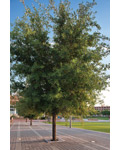
www.ironsmith.cc
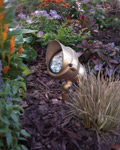
www.KimLighting.com
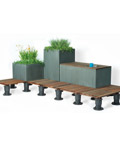
www.BisonIP.com









